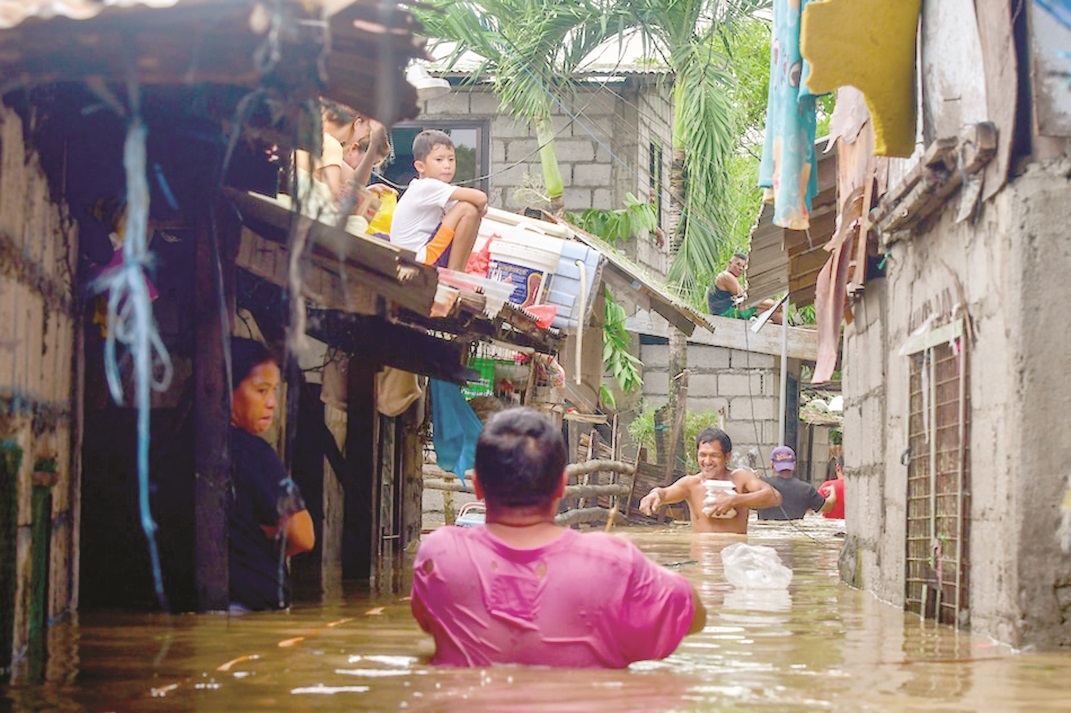6 dead as Noru barrels through Philippines
Published on: Tuesday, September 27, 2022
By: AFP
 Deep floods inundate residential homes in Brgy. Poblacion, San Miguel, Bulacan.
Deep floods inundate residential homes in Brgy. Poblacion, San Miguel, Bulacan.
SAN ILDEFONSO: The strongest typhoon to hit the Philippines this year left at least six people dead, authorities said Monday, after heavy rain and fierce winds battered the country’s most populous island.Typhoon Noru toppled trees, knocked out power and flooded low-lying communities as it swept across Luzon on Sunday and Monday.
ADVERTISEMENT
There have so far been no reports of widespread severe damage from the storm, which hit the country as a super typhoon.
“We were ready for all of this,” President Ferdinand Marcos Jr told a briefing with disaster agencies.
“You might think that we overdid it. There is no such thing as overkill when it comes to disasters.”
Five rescuers were killed after they were sent to help flooded residents in San Miguel municipality in Bulacan province, near the capital Manila.
ADVERTISEMENT
“They were deployed by the provincial government to a flooded area,” said Lieutenant-Colonel Romualdo Andres, chief of police in San Miguel.
Andres said the rescuers were wading through floodwaters when a wall beside them collapsed, sending them into the fast current.
ADVERTISEMENT
An elderly man died after he was hit by a landslide in Burdeos municipality on the Polillo islands, part of Quezon province, where the storm made landfall, said Garner Jimenez from the local civil defence office.
The Philippines is regularly ravaged by storms, with scientists warning they are becoming more powerful as the world gets warmer because of climate change.
Noru smashed into the archipelago nation on Sunday after an unprecedented “explosive intensification” in wind speeds, the state weather forecaster said earlier.
It made landfall about 100 kilometres (62 miles) northeast of the densely populated capital Manila, before weakening to a typhoon as it crossed a mountain range, coconut plantations and rice fields.
Nearly 75,000 people were evacuated from their homes before the storm hit, as the meteorology agency warned heavy rain could cause “serious flooding” in vulnerable areas, trigger landslides and destroy crops.
But on Monday there was no sign of the widespread devastation many had feared, as the storm moved over the South China Sea towards Vietnam.
Aerial footage taken during Marcos’s inspection flight over central Luzon showed rivers that were swollen or had burst their banks, and patches of farmland under water.
Burdeos municipality on the Polillo islands bore the brunt of Noru.
Ferocious winds ripped off some roofs and brought down large trees while heavy rain flooded riverside houses, said Ervin Calleja, a 49-year-old teacher.
“It was really worrisome,” Calleja told AFP by phone.
“The wind was whistling and it had heavy rains. That’s the more dangerous part.” Flimsy houses along the coast were damaged and some crops were wiped out.
“Here at the town centre all banana trees were flattened, 100 percent,” said Liezel Calusin, a member of the civil defence team in Polillo municipality.
“We still have no electricity, but the phones are working.”
In Banaba village near Manila, Terrence Reyes fled his riverside home with his family and neighbours as floodwaters rose during the storm.
They returned home Monday to find their belongings sodden and caked in mud.
“We just have to throw them away and start over again,” Reyes, 25, said.
“It happens each time there is a storm here.”
The Philippines—ranked among the most vulnerable nations to the impacts of climate change—is hit by an average of 20 storms every year.
At least 200 sacks of garbage were collected from Manila Bay Dolomite Beach on Monday, hours after Typhoon Karding hit Metro Manila and some provinces in Luzon.
Authorities said most of the trash collected were plastic waste such as water bottles and sachets.
Despite the water booms surrounding the beach, the floating trash were washed in with the waves.
The beach has undergone several cleanup drives since it was opened to the public in 2021.
Earlier this year, the P389-million artificial beach was closed for the second phase of rehabilitation in which an additional P265-million budget was allocated to the project.
When the dolomite beach first opened to the public in September last year, it was hounded by controversies as several environmental groups and experts raised concerns about the supposed dangers of crushed dolomite on the environment.
The DENR maintained that the dolomite sand used for the man-made beach was safe.
Stay up-to-date by following Daily Express’s Telegram channel.
Daily Express Malaysia










